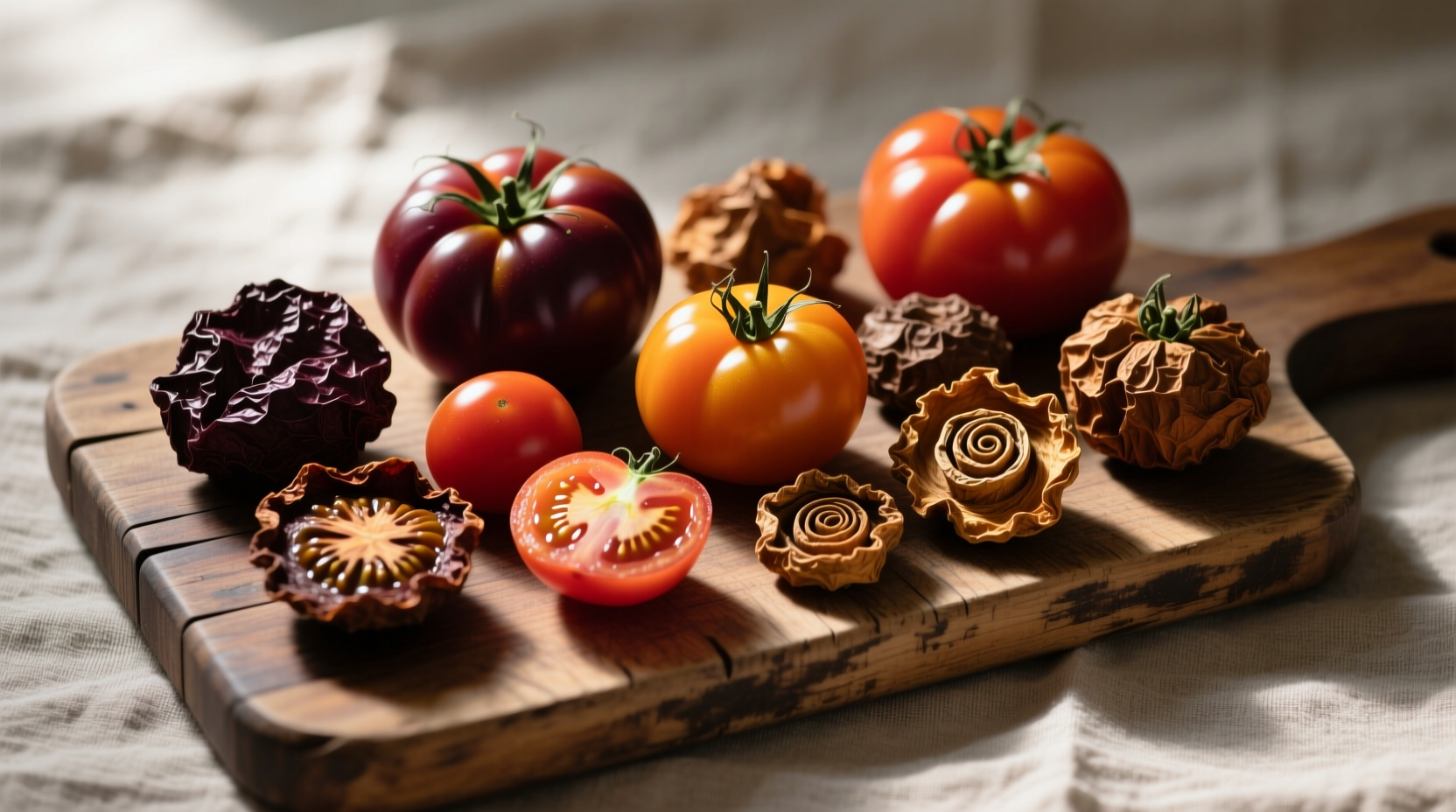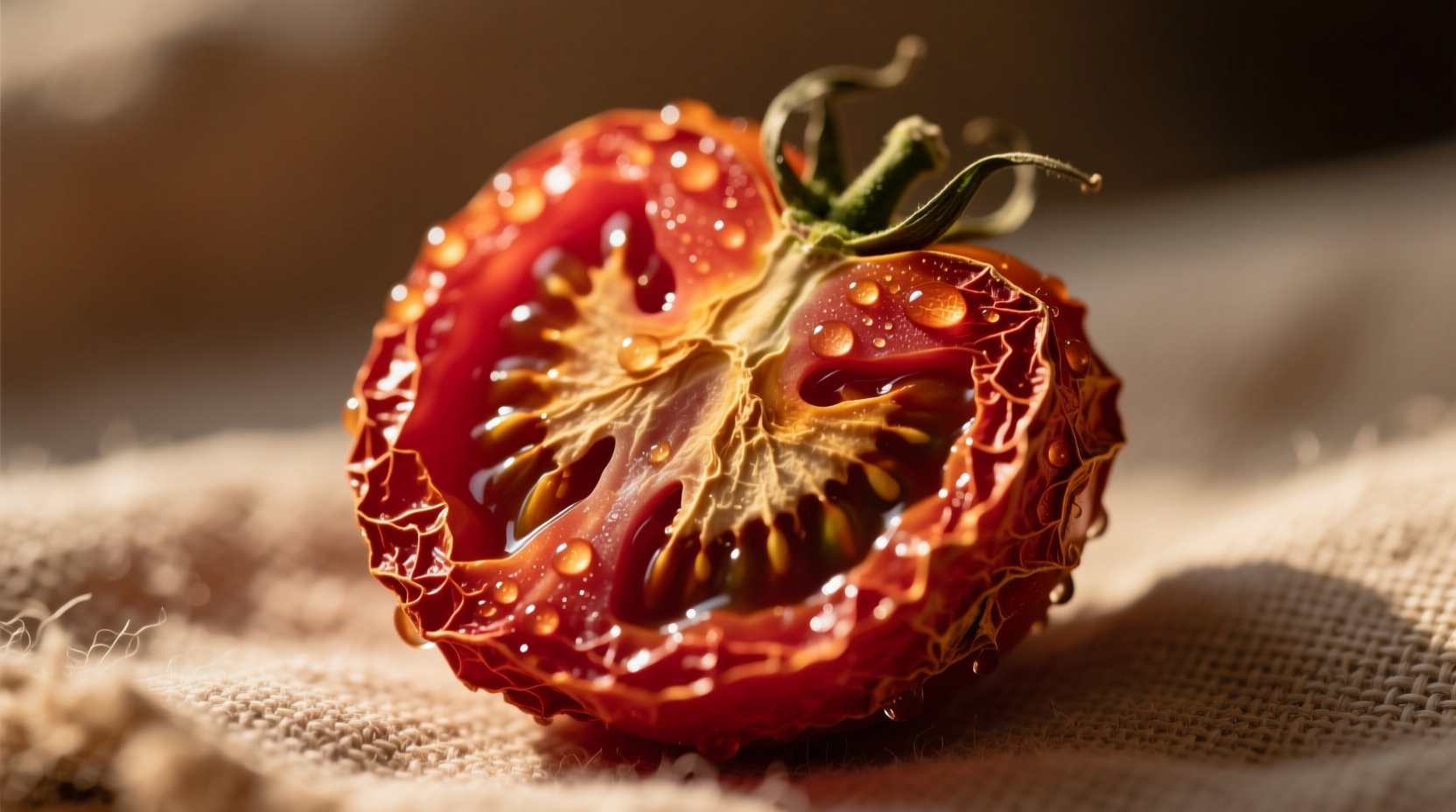Dried tomatoes transform ordinary dishes with concentrated flavor that fresh tomatoes can't match. When you understand how to select, store, and use them properly, these shelf-stable ingredients become your secret weapon for restaurant-quality meals at home. This comprehensive guide reveals exactly what makes dried tomatoes nutritionally valuable, how different drying methods affect flavor profiles, and professional techniques for maximizing their culinary potential.
What Exactly Are Dried Tomatoes?
Dried tomatoes undergo controlled dehydration that removes approximately 90-95% of their water content while preserving essential nutrients and developing complex flavor compounds. Unlike canned tomatoes that maintain high moisture content, dried tomatoes concentrate natural sugars and acids through the Maillard reaction during the drying process, creating deeper umami characteristics.
The practice of drying tomatoes dates back centuries, with historical evidence showing Mediterranean cultures preserving summer harvests through sun-drying as early as the 16th century. Modern methods have evolved significantly while maintaining the same fundamental principle of moisture removal for preservation and flavor concentration.
Evolution of Tomato Drying Techniques
- 1500s-1800s: Traditional sun-drying on flat stones in Mediterranean regions
- Early 1900s: Introduction of wood-fired drying ovens for more consistent results
- 1970s: Commercial dehydration technology enables mass production
- Today: Precision-controlled dehydration preserves maximum nutrients while developing complex flavor profiles
Nutritional Comparison: Fresh vs. Dried Tomatoes
| Nutrient (per 100g) | Fresh Tomatoes | Dried Tomatoes |
|---|---|---|
| Calories | 18 kcal | 258 kcal |
| Water Content | 95% | 5-10% |
| Lycopene | 257 μg | 23,700 μg |
| Vitamin C | 14 mg | 18 mg |
| Dietary Fiber | 1.2 g | 13.5 g |
Source: USDA FoodData Central, National Center for Home Food Preservation
This nutritional concentration explains why dried tomatoes deliver significantly more lycopene—a powerful antioxidant associated with reduced risk of heart disease and certain cancers—than their fresh counterparts. The drying process actually increases lycopene bioavailability by breaking down cell walls that normally trap this nutrient.

Practical Applications in Your Kitchen
Understanding when and how to use different dried tomato formats transforms your cooking results. The three primary forms each serve distinct culinary purposes:
Sun-Dried Tomatoes (Oil-Packed)
These ready-to-use tomatoes offer immediate flavor impact with minimal preparation. Their oil infusion creates a rich, rounded flavor profile ideal for:
- Adding directly to pasta dishes and grain salads
- Blending into pesto for enhanced depth
- Chopping finely for sandwich spreads and dips
Dry-Pack Dried Tomatoes
These shelf-stable versions require rehydration but deliver superior concentrated flavor. Professional chefs prefer them for:
- Building flavor foundations in sauces and soups
- Creating intense tomato powders for seasoning
- Infusing oils with pure tomato essence
When to Choose Which Type
- For immediate use: Oil-packed tomatoes (no rehydration needed)
- For maximum flavor concentration: Dry-pack tomatoes (rehydrate in warm broth)
- For long-term storage: Dry-pack tomatoes (store up to 2 years in airtight containers)
- For oil-based dishes: Oil-packed tomatoes (adds flavor to the cooking medium)
Mastering Rehydration Techniques
Proper rehydration unlocks the full flavor potential of dry-pack dried tomatoes. Skip this critical step and you'll end up with chewy, unevenly flavored ingredients. Follow these professional methods:
- Hot Liquid Method: Cover tomatoes with boiling broth or water and let stand for 15-20 minutes until plump
- Cold Soak Method: Soak in room temperature liquid for 2-3 hours for more delicate texture
- Wine Infusion: Rehydrate in red wine for dishes requiring complex acidity
Never use plain water for rehydration—always incorporate flavorful liquids like tomato juice, vegetable broth, or wine. Reserve the soaking liquid; it contains concentrated tomato essence perfect for enhancing sauces and soups.
Storage Guidelines for Maximum Freshness
Improper storage causes dried tomatoes to lose flavor and develop off-notes. Follow these evidence-based storage methods:
- Oil-packed tomatoes: Store unopened jars in cool, dark place for up to 1 year; after opening, keep submerged in oil in refrigerator for 6 months
- Dry-pack tomatoes: Transfer to airtight containers with oxygen absorbers; store in cool, dark place for 18-24 months
- Homemade dried tomatoes: Store in vacuum-sealed bags with moisture absorbers for 12 months
Check for spoilage by examining for mold, off-odors, or excessive oil cloudiness. Properly stored dried tomatoes should maintain deep red color and pliable texture—not hard and brittle.
Creating Professional-Quality Dried Tomatoes at Home
Commercial dried tomatoes often contain preservatives and excess oil. Making your own ensures pure flavor and optimal texture. Here's the chef-recommended method:
- Select ripe Roma tomatoes (lower water content than beefsteak varieties)
- Cut lengthwise and remove seeds and excess gel
- Arrange cut-side up on dehydrator trays
- Dry at 135°F (57°C) for 8-12 hours until leathery but not brittle
- Condition by storing in airtight container for 7-10 days to equalize moisture
For oven drying, set to lowest temperature with door slightly ajar. Rotate trays periodically for even drying. The finished product should bend without breaking and feel dry to the touch.
Buying Guide: What to Look For
Navigate supermarket choices with confidence using these professional selection criteria:
- Color: Deep, uniform red without dark spots or browning
- Texture: Leathery and pliable, not hard or brittle
- Oil content: For oil-packed, oil should be clear not cloudy
- Ingredients: Tomatoes and salt only (avoid sulfites if sensitive)
- Packaging: Vacuum-sealed or in dark glass to prevent light degradation
Higher quality dried tomatoes develop complex flavor notes beyond simple tomato taste—look for subtle hints of caramel, dried fruit, and earthiness that indicate proper drying and maturation.
Common Questions About Dried Tomatoes
Frequently Asked Questions
Can I substitute dried tomatoes for fresh in recipes?
Dried tomatoes work as substitutes only when rehydrated properly. Use 1 part dried tomatoes to 3 parts liquid, then substitute 1:1 for fresh tomatoes by volume. Note that flavor intensity will be significantly higher.
Are sulfites in dried tomatoes harmful?
Sulfites preserve color but can trigger reactions in sensitive individuals. Choose "no sulfites added" varieties if you have asthma or sulfite sensitivity. Naturally dried tomatoes without sulfites will be darker but equally nutritious.
How do I make tomato powder from dried tomatoes?
Grind completely dry tomatoes in a spice grinder until fine. Sift through a fine mesh strainer, then regrind any larger pieces. Store in an airtight container away from light for up to 1 year. Use as seasoning for soups, sauces, and rubs.
Why do my homemade dried tomatoes mold?
Insufficient drying or improper storage causes mold. Tomatoes must reach 10% moisture content or less. Condition properly by storing in airtight containers for 7-10 days, checking daily for moisture condensation which indicates incomplete drying.











 浙公网安备
33010002000092号
浙公网安备
33010002000092号 浙B2-20120091-4
浙B2-20120091-4